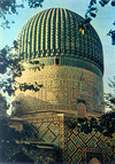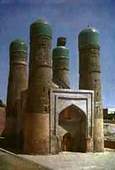|
English
Russian |
 |
 |
There are more than 160
Muslim relics located in Uzbekistan. This proves the special importance
of Uzbekistan for the whole Islamic world. In the Middle Ages the territory
of Uzbekistan was not only a large political and cultural power, but also
an important religious center. The religious scientist-theologians of
Bukhara like Mukhammad Imam al-Bukhari, abu Khavsi Kabir, Sayf-ad-Din
Bokharzi, the founder of the Tarikat Nakshbandiya, and Mukhammad Bakha-ad-Din
Nakshband are widely known in the Islamic world. In Bokohoroi-Sharif,
sacred Bukhara, in the Rome of Asia - Samarkand, in Tashkent and Khiva,
among the hundreds of religious structures the numerous and most interesting
from the point of view of architecture are mausoleum, mosques, medreses
and other structures.
Three periods can be mentioned in the evolution of the architecture of
religious structures: the 7th-12th cc, the period of formation of religious
construction; the 15th-17th cc, the period of its flourishing and finally
the 18th-20th cc, the period characterized by the decrease in the construction
of mosques.
The Soviet period was characterized by almost full stagnation in Islamic
religious construction; most of the religious relics and structures were
ruined. Only after independence were the mosques and relics reconstructed
to achieve their original appearance and importance.
The Ensemble of Bakhaaddin Nakshbandi of the 15th century
Being very esteemed in Bukhara, Sheikh Bakhaaddin Nakshbandi (died in
1389) was the tutor of Timur, and a tailor in his early life. He produced
silk textiles with golden embroidery and subsequently became the protector
of all crafts. Worshiping the holy grave of the sheikh was equal to the
Hadj to Mecca. In the 1980s the Bukhara adherents of Bakhaaddin (the protector
of Bukhara) reconstructed the memorial complex by khahshar (collective
working without payment).
Before Islam there was a pagan temple here, with which the holiday of
the red rose is related. This holiday was celebrated annually near mazar.
In 1544 by the order of the khan Abdulaziz I, in honor of the sheikh,
a dakhma with carved marble fencing and a great structure of khanaki (42.5
x 38) were constructed. After many years the dakhma was moved to a distinct
courtyard with a khauz (pond) in its center and with painted mosques of
Muzaffarkhan and Khakum Kushbegi. On the bank of the khauz there is a
picturesque four-flat chartak (sakkhana). A minaret and a small medrese
are located in front of the facade of the Kushbegi mosque. Westwards from
the dakhma in a distinct courtyard there is a large necropolis, the burial-vault
of the governors of Bukhara.
The spirituality of expressive architectural structures, and the calmness
and seclusion of the ensemble attracted religious people, encouraging
them to pray to God.
Chor Bakr (16th-18th centuries)
The mazar on the grave of the founder of the djuybar khadjes, Abu Bakr
Sad, known as Chor Bakr, was very popular in Bukhara. This grandchild
of a famous Bukhara sufi, khadji Islam Djuybari (16th c) made an important
contribution to the accomplishment of the mazar. In the four parts (charbag)
of this garden there are other trees as well. 6 km from the gate of the
city two aryks were laid and trees were planted along them. This green
path, Khiaban, connected Chor Bakr with Bukhara. The construction of Chor
Bakr continued for a long time. A group of family funeral yards, khazira,
appeared along the traditional corridor. The front central complex of
khanaka, mosque and medrese is directed towards it. The space between
them is taken up by a medrese. And the importance of the structures is
emphasized by the minaret.
A narrow path leads to the family crypts. The entrance portals, darvaza
and ayvans of the memorial mosques are built in the brick walls of the
yards.
The ensemble of Shakhi Zinda (12th-15th centuries)
The modest and chaste wives and sisters of Amir Timur expressed their
wish to be buried on the threshold of this place, which is guarded by
angels, wrote Abu Takhir Khodja. The structures here rise up to the azure
sky. They are decorated and beautiful structures, as if the sky-blue cupola
opens its eyes to the Moon and the Sun. The blue shining burial-vault
lies along the ancient hills of Afrosiab. The major relic is the mazar
on the top of the hill, which is believed to belong to Kusam, the son
of Abbas, who is the cousin of the prophet Muhammad. The ritual of worshiping
his grave was formed in ancient times. There is a legend about him, about
Shakhi Zinda, the living king. This personage is known in Central Asia
from ancient times and is related to the figure of Siyavush, the suffering
deity. This originated in the ancient cult of suffering and dying deities.
According to archeological research, the territory of the necropolis was
a part of the ancient city till the 11th c. The bases and crypts of the
first structures of the ensemble are from the 12th c. In the 13th c, after
the Mongolian conquer, the people abandoned the old fortress and Shakhi
Zinda was empty for a long time. At the beginning of 14th c, mausoleums
began to arise on the lands of Shakhi Zinda. By the time Timur died (February,
1405) the structures of Shakhi Zinda were located within the borders of
ancient Samarkand. Later, during the reign of Ulugbek the structures of
the lower group were built on the remains of Afrasiab. A wide staircase
was built to reach the top of Afrasiab. The structures of the lower group
were completed in the period of 1434-1435. The writing on the portal says:
This great building was founded by Abdulazizkhan, the son of Ulugbek Guragan,
the son of Shakhrukh, the son of Amir Timur Guragan in 838/1434 AD. The
complex of mausoleums Shakhi Zinda is very popular among religious people.
Even at the beginning of 20th c, every Thursday zeals of dervishes of
the Kadiriya order were held here. The ceremony djarkhiya (a loud zeal)
began in the upper mosque; then spelling the word kho or khu, the participants
came down along the long stairs to the lower mosques. Before the end of
the ceremony the singing of religious poems (khofiz) was performed.
The Ensemble of Zangiata (late 14th-15th centuries)
Islam became a widespread state religion in the 19th c. Nevertheless along
with the official Islam, some popular mystical sects also developed. The
preachers of these religious movements were the sufis, the founders of
the sufi sects and the dervish orders.
According to the legends, the two one-chamber mausoleums of the popular
Tashkent sufi Zangiota and his wife Ambar bibi were built by Timur in
the 14th c. His name was Aykhodja nicknamed Zangiota, which means the
black. Born in the settlement of Sham and being the descendant of Khozrat
Arslanbaba he was the fifth murid of the sufi Khoja Akhmad Yassavi, who
was considered to be the religious patron of all the Turkic tribes of
Central Asia. Worshiping the cult of Zangiota on holiday turned into a
mass celebration with performances of acrobats, magicians and dervishes.
The Ensemble of Ismail
Bukhari (16th-19th centuries)
The mazar of Mukhammad ibn Ismail Bukhari is located 12 kilometers from
Samarkand. It is known as the mazar of Khedja Ismail. Here near the grave
of Ismail a cathedral mosque was built.
Imam Ismail Bukhari lived in the 9th c and is known as the collector of
7275 khadises - the legends about the life and activity of Muhammad and
the author of Saikh, i Bukhari. This collection of khadises is the fullest,
the most authentic and canonical in Islam. In Samari Abu Takhir Khodja
tells about the miraculous influence of this sacred person on epidemics.
The grandfather of imam Muhammad was a fire-worshipper. He accepted Islam
and his son was a good narrator of folk tales about the life of the prophet,
which consequently were included into Sunna, which gave them the status
of laws for Muslims.
Mazar of Khadja Akhrar (15th-19th centuries)
Khodja of Khodjas - he who understands the point of the matter. This is
how Abdurakhman Djami described one of the most influencial sheikhs of
the Temurid epoch, Ubaydulla Khodja Akhrar. He bent the people's will
with his perfect power. He had a handsome appearance and wonderful spiritual
qualities. His spiritual power applied not only to his followers, but
also to governors. The sheikh himself was an educated theologian and wrote
poems. He died in 1490 and was buried in dakhma in a mausoleum with a
facing made of white carved marble. In the khazir of khadja Akhrar other
important religious people are also buried.
In 1638 by the order of Nadir Divanbegi, the architect Dostmukhammad a
large medrese, was built near the tomb of the sheykh. It was considered
as the mirror Shyr Dar. Later, a summer mosque with patterned ceiling
and khanaka was built near the ancient khauz. A small minaret was raised
in the shadows of chinars. Even now the call to pray which comes from
the minaret can be heard.
|
|



|


